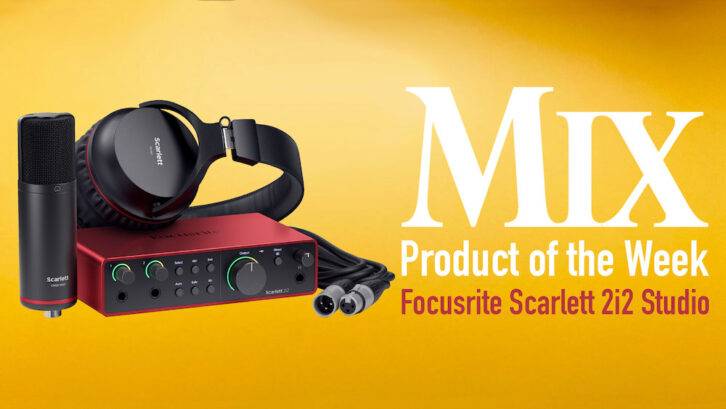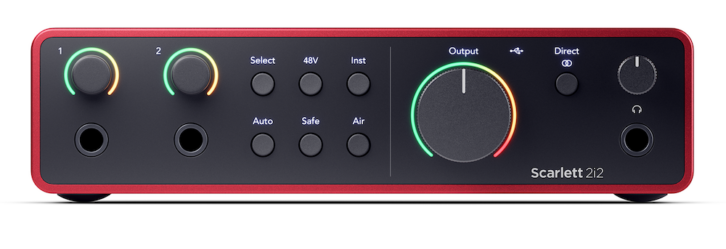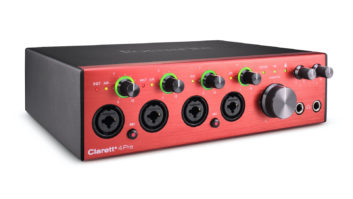
| MIX VERDICT: FOCUSRITE SCARLETT 2I2 STUDIO |
| THE TAKEAWAY: “The Scarlett 2i2 4th Gen is a no-brainer.” |
| COMPANY: Focusrite • www.focusrite.com PRICE: $199.00 (interface only); $299.00 Scarlett 2i2 Studio (hardware bundle). PROS: • Easy to use. • Excellent sound quality. • Friendly interface. CONS: • No pad on the mic preamp input. • App settings can’t be saved. |
Originally introduced in 2011, the Focusrite Scarlett 2i2 has undergone several revisions, first in 2016 (2nd Gen), then in 2019 (3rd Gen) and now a revision to 4th Gen.
The 2i2 is Focusrite’s best-selling interface, and could possibly be the best-selling audio interface ever produced, with the company reporting that more than six million Scarlett-series interfaces have been sold to date. The 2i2’s popularity has been fueled by ease of use, a compact form factor, high-quality audio, and a reasonable price. The latest iteration continues those traditions, this time incorporating converters from Focusrite’s flagship RedNet series to achieve a dynamic range of 120 dB, while supporting resolutions up to 192 kHz/24-bit.
The 2i2 4th Gen has numerous revisions over its predecessor.The microphone preamp has been redesigned to provide 69 dB of gain—a 13 dB increase over the previous preamp. The preamps may be remote-controlled using the Control 2 app, and feature Auto Gain, Clip Safe and two different “Air” modes (more on that in a moment). A new headphone amp reduces distortion, improves dynamic range and delivers enough power to drive high-impedance headphones to comfortable listening levels. Meanwhile, the 2i2 4th Gen line outputs also received a facelift, and now boast reduced distortion (-112 dB) and a maximum output level of 16 dBu.
The folks at Focusrite sent Mix the Scarlett 2i2 Studio package, which includes a Scarlett 2i2 interface, SH-450 headphones, CM25 MkIII condenser microphone, microphone cable, USB Type C-to-A cable, and a cardboard microphone stand that’s integrated into the packaging. The components make a great introductory bundle for the novice, but for the purposes of this review, we’ll concentrate on the Scarlett 2i2.

UP-FRONT
The front panel of the 2i2 is neatly arranged with input controls on the left and output controls on the right. Two rotary encoders with halo meters set input level for the front-panel 1/4-inch inputs or rear-panel XLR microphone inputs (plugging a cable into a 1/4-inch jack disables the respective XLR input). A set of six buttons control preamp functions, starting with Select, which toggles control between the two channels. The remaining controls are 48V (which applies to both channels), Inst (toggles the 1/4-inch input between instrument and line level), Auto (starts the Auto Gain process), Safe (turns on Clip Safe), and Air, which cycles through three settings: Off, Air Presence, or Air Presence + Drive. The right side of the unit features a large output level knob with halo meter, a USB status LED, Direct Monitor (Off/ Mono/Stereo), and a 1/4-inch headphone jack with dedicated volume control.

The rear panel features the XLR microphone inputs, a pair of 1/4-inch speaker outputs, a USB-C port for connection to a computer, a second USB-C port for power, and a port for a Kensington lock. The 2i2 draws a fair amount of current (900 mA) via the USB bus, so in the event that your computer cannot provide sufficient power, the secondary USB port can be used for a dedicated USB power supply. The secondary port is also helpful when using the 2i2 in Standalone mode.
The first time you connect the 2i2 to your computer, you’ll be prompted to go through the Easy Start process whereby you can register the unit with Focusrite, and download and install the Control 2 app. Registering the 2i2 ensures you can access license codes for the software bundled with the 2i2—and there’s a lot of useful stuff, including an assortment of plug-ins from Focusrite, Ableton Live Lite, and three-month trials of Auto-Tune Unlimited and Pro Tools Artist.
IN THE STUDIO
I started my tests by connecting the 2i2 4th Gen to my laptop and listening to some mixes. Since I have a 2i2 3rd Gen, I was able to compare it with the newer unit, and it was immediately apparent that the headphone amp in the 4th Gen unit is more transparent than 3rd Gen, though it’s tough to say if this is an attribute of the amp, the D/A circuitry or both. The 2i2 4th Gen is smoother in the upper-mids, has a more extended bottom end and resolves low-level detail better than 2i2 3rd Gen. The 2i2 4th Gen headphone amp has the ability to drive my ancient AKG K240s to higher levels than the 2i2 3rd Gen, and 4th Gen could drive my monitors to slightly louder levels than the 3rd Gen unit as well.
I made a few brief recordings of an acoustic guitar using a Neumann U87, first with the 2i2 Gen3 unit and then using the 2i2 4th Gen.
Recordings made with the 2i2 4th Gen sounded natural and well-balanced, and I noticed that the top end was more open and extended than that of the 3rd Gen.
I then used the 2i2 4th Gen to record a voiceover using a Shure SM7B, which has a notoriously low output level. Using this mic with the 2i2 3rd Gen, I was only able to achieve record levels that I’d consider barely acceptable even with maximum gain. Using the 2i2 4th Gen, however, I was able to record the microphone at healthy levels with no sacrifice in the noise floor.
The extra gain provided by the 4th Gen preamps was also welcome when I recorded acoustic guitar and vocal tracks using a Royer R10 ribbon microphone. In this application, the 2i2’s Air Presence mode was perfect for adding a bit of sparkle to the acoustic guitar, or some presence to a lead vocal. I tried Air Presence + Drive on a few different instruments, but found it most useful on a DI’d electric guitar where it breathed some life into the instrument, and a male lead vocal for an alt rock track where it easily pushed the vocal to the front of the mix.
Turning on Auto Gain initiates a listen mode whereby the 2i2 analyzes approximately 10 seconds of audio and sets preamp gain based upon the input signal. I consistently found the preamp settings using Auto Gain to be on the conservative side (i.e., levels were lower than I’d like), but it was easy enough to tweak settings a few dB higher afterward to get in the ballpark.
Pushing the Safe button engages the 2i2’s Clip Safe mode, whereby the unit monitors input level and automatically adjusts the gain to avoid clipping. Safe worked better on signals with a slow attack than it did on transients, and I didn’t like the fact that turning it on always immediately reduced the gain setting, regardless of whether there was input signal or not. It should be mentioned that Air and Safe modes are disabled at sample rates of 176.4 and 192 kHz.
CONTROL 2
Focusrite Control 2 is the free app that enables computer control over sample rate and preamp parameters. It’s a simple but elegant UI that should be self-explanatory to inexperienced users, and the input metering is a nice complement to the meters on the 2i2 chassis. Grabbing a gain knob adjusts input level, and a numeric readout above the multicolored level meter indicates headroom dBFS—very useful information, especially when recording alone. Software controls mirror those on the 2i2, a nice addition being Control 2’s drop-down menu for the Air settings.
THE 2I2 STANDS ALONE
The 2i2 can be run in Standalone mode, which allows audio to pass even if the 2i2 is not connected to a computer. This could be useful for monitoring a synth or electric guitar without needing to boot up a computer. It also allows the 2i2 to be used as a conventional mic preamp. Standalone requires power via one of the USB-C ports, and the 2i2 must be switched to Direct Monitor mode.
There’s a lot to like about the Scarlett 2i2 4th Gen. It’s easy to set up and use, it sounds really good, and has enough gain to deal with low-output microphones. Direct Monitor allows latency-free monitoring at the push of a button. Though it only has two hardware inputs, the 2i2 4th Gen also provides a pair of loopback inputs that facilitate capturing audio output from your computer (though you’ll need to mute the channels in your DAW to avoid creating a feedback loop). It’s very affordable, and the noise floor of the monitor outputs is significantly lower than that of the 2i2 3rd Gen. Whether you’re looking for your first interface, or need an interface that you can toss in a backpack and use for remote recordings, the Scarlett 2i2 4th Gen is a no-brainer.







